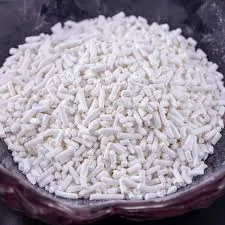
Understanding the Role of Sodium Metabisulfite in Water Treatment Applications
Sodium Metabisulfite in Water Treatment Applications and Benefits
Sodium metabisulfite, a white crystalline powder, has emerged as a critical agent in various water treatment processes. Commonly used for its reducing properties, this compound serves multiple purposes, from disinfection to dechlorination. Understanding its role and benefits can help municipalities and industries make informed decisions about water management.
The Chemical Properties of Sodium Metabisulfite
Sodium metabisulfite, chemically represented as Na2S2O5, is a sulfite salt formed by the reaction of sulfur dioxide with sodium hydroxide. It is highly soluble in water and often appears as a white powder or granule. Due to its weakly acidic nature, it releases sulfur dioxide upon contact with acids, which contributes to its reducing capabilities.
Disinfection and Removal of Chlorine
One of the primary applications of sodium metabisulfite in water treatment is its use as a disinfectant. In municipal water systems, chlorine is commonly used for water disinfection due to its effectiveness in killing pathogens. However, residual chlorine in water can pose health risks and affect water quality. Here, sodium metabisulfite acts as a dechlorinating agent, neutralizing chlorine and forming harmless byproducts. This not only improves water quality but also enhances the safety and taste of drinking water.
Anti-Fouling Agent
sodium metabisulfite in water treatment

Sodium metabisulfite is also utilized in industrial water treatment systems, including cooling towers and boilers. It serves as an anti-fouling agent, preventing the formation of scale and biofilm, which can cause operational inefficiencies and increase maintenance costs. By controlling the growth of microorganisms and the deposition of salts, sodium metabisulfite plays a pivotal role in prolonging equipment life and ensuring optimal performance.
Preservation of Food and Beverages
In addition to water treatment, sodium metabisulfite finds its application in the preservation of food and beverages. Due to its antioxidant properties, it is often used to inhibit the oxidation of foodstuffs, preventing spoilage and enhancing shelf life. This dual functionality in both food preservation and water treatment highlights the versatility of sodium metabisulfite as a significant compound in public health and safety.
Environmental Considerations
When implementing sodium metabisulfite in water treatment processes, it is critical to consider the environmental implications. While it is generally recognized as safe when used correctly, excessive application can lead to the release of sulfites into the environment, potentially impacting aquatic ecosystems. Therefore, it is essential for municipal and industrial water systems to monitor and regulate its use to ensure that it meets safety standards and does not adversely affect natural water bodies.
Conclusion
Sodium metabisulfite is an invaluable asset in the realm of water treatment. Its multifunctionality, ranging from dechlorination and disinfection to anti-fouling properties, underlines its importance in maintaining water quality and safety. As industries and municipalities continue to seek effective and environmentally responsible water treatment methods, sodium metabisulfite offers an efficient solution that promises improved water management practices. Through proper application and regulation, sodium metabisulfite can significantly contribute to both public health and environmental sustainability.
-
Pure Sodium Dichloroisocyanurate Dihydrate | Powerful DisinfectantNewsAug.29,2025
-
Industrial Chemicals: Quality & Purity for Every IndustryNewsAug.28,2025
-
Nitrile Rubber Honoring Strict Production StandardsNewsAug.22,2025
-
Aspartame Ingredients Honoring Food Safety ValuesNewsAug.22,2025
-
Fertilizer for Balanced Plant NutritionNewsAug.22,2025
-
Cyanide Gold Processing with High Purity AdditivesNewsAug.22,2025
-
Formic Acid in Textile Dyeing ApplicationsNewsAug.22,2025
Hebei Tenger Chemical Technology Co., Ltd. focuses on the chemical industry and is committed to the export service of chemical raw materials.
-

view more DiethanolisopropanolamineIn the ever-growing field of chemical solutions, diethanolisopropanolamine (DEIPA) stands out as a versatile and important compound. Due to its unique chemical structure and properties, DEIPA is of interest to various industries including construction, personal care, and agriculture. -

view more TriisopropanolamineTriisopropanolamine (TIPA) alkanol amine substance, is a kind of alcohol amine compound with amino and alcohol hydroxyl, and because of its molecules contains both amino and hydroxyl. -

view more Tetramethyl Thiuram DisulfideTetramethyl thiuram disulfide, also known as TMTD, is a white to light-yellow powder with a distinct sulfur-like odor. It is soluble in organic solvents such as benzene, acetone, and ethyl acetate, making it highly versatile for use in different formulations. TMTD is known for its excellent vulcanization acceleration properties, which makes it a key ingredient in the production of rubber products. Additionally, it acts as an effective fungicide and bactericide, making it valuable in agricultural applications. Its high purity and stability ensure consistent performance, making it a preferred choice for manufacturers across various industries.





